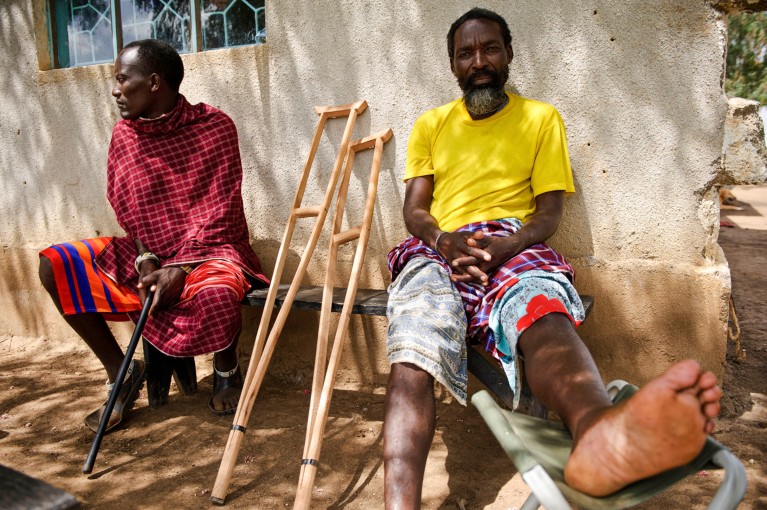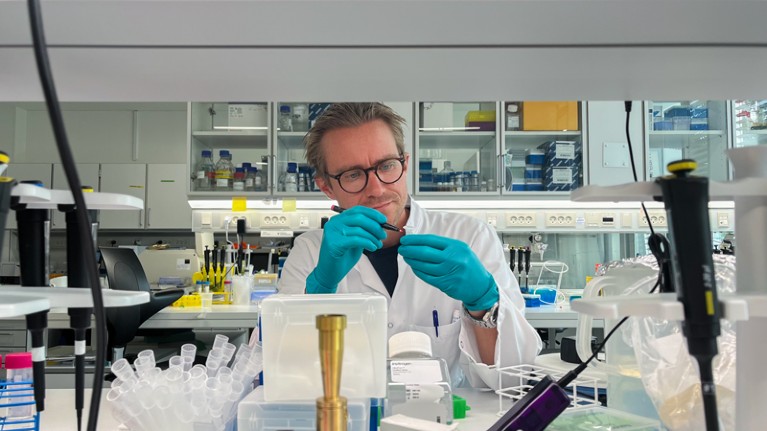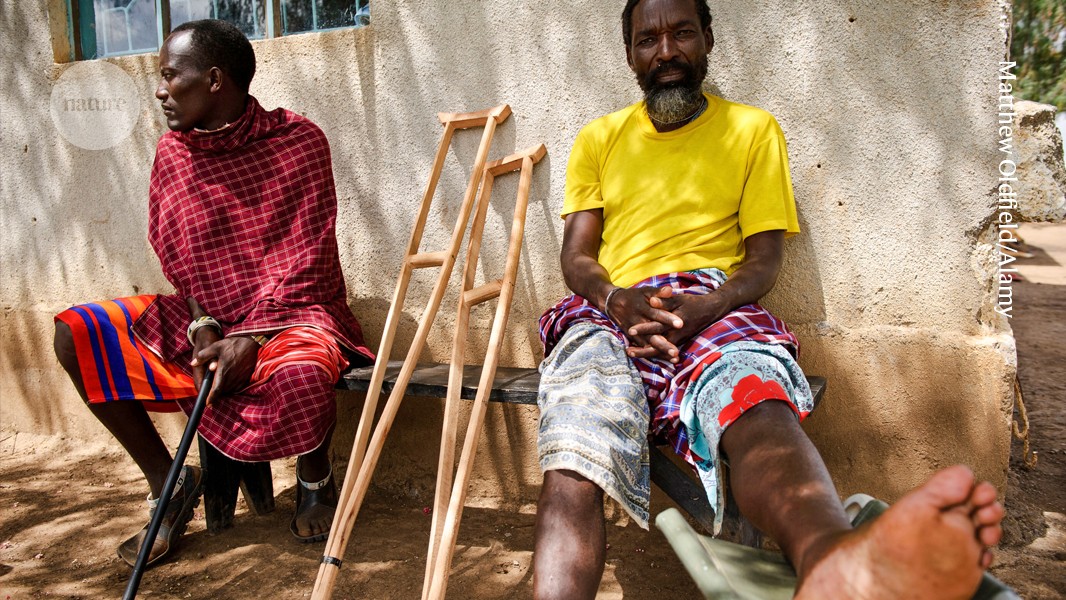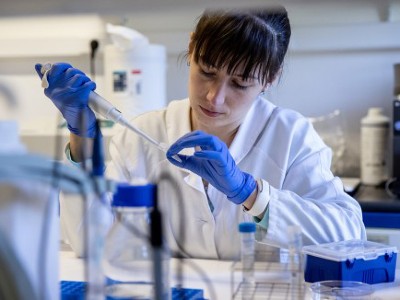
Snakebite clinic patients in Meserani, Tanzania. Credit: Matthew OldfieldCredit: Matthew Oldfield Editorial Photography/Alamy
Andreas Laustsen-Kiel leads the Center for Antibody Technologies at the Technical University of Denmark (DTU) in Kongens Lyngby. His role straddles academia and research commercialization, and his current focus is on snakebites, allergy, cancer and infectious diseases.
Laustsen-Kiel says his entrepreneurial experiences pre-date the formal launch of his career in science, because he co-founded Biosyntia, his first biotechnology company, in 2012, while doing a master’s programme in advanced and applied chemistry at the DTU.
Biosyntia manufactures vitamins and other dietary ingredients using microbial fermentation. In 2013, Laustsen-Kiel co-founded VenomAb, which aimed to develop the world’s first recombinant antivenom against snakebites. The company closed four years later, but its work lives on as a DTU research project, led by Laustsen-Kiel and funded by Wellcome in London.
The university “spin-in”, as he terms it, happened because, despite there being a clear clinical and societal need for the products, it would have been hard for the company to deliver a financial return on investments. Laustsen-Kiel has now co-founded eight companies in total.
Tell us how snakebites helped to launch your career as an entrepreneur.
In 2011, I was in Tanzania with my family and we came across a snakebite clinic where two children had had amputations, one at the elbow, the other at the knee. That left a strong impression.
I knew snakebite was a serious medical emergency, but had wrongly assumed that antivenoms, which have been around for almost 130 years, would have been available. I was amazed to discover that antivenoms are still being manufactured by immunizing horses and extracting their serum, rather than by using monoclonal antibodies.
In 2013, I participated in a start-up competition run by Venture Cup Denmark, an association of Danish universities, and suggested to my team choosing snakebite as the problem to tackle in our business idea entry. Snake venom is a more complex drug target than we expected. Discovering this made us more passionate about delivering societal impact, saving lives and limbs.
Our passion was shared by people working with neglected tropical diseases. They seem more passionate about what they do than many other scientists I have met. It’s an environment in which you don’t feel in competition to publish or be the first to earn money.
I wouldn’t say we’ve made a societal impact yet, but I think we’ve made a scientific one. These days, nobody questions whether you can make better antivenoms using recombinant DNA technology and monoclonal antibodies. The question is how to manufacture and deploy them.
You’ve now co-founded eight companies. How do you juggle so many?
In a sense it’s like having children. Every one is different. What works for one might not necessarily work for another.
With Biosyntia and VenomAb, it was mainly about making a business plan, and coming up with a concept and a pitch, then doing the science afterwards.
It’s the opposite now I have much more scientific training, a track record, a research group and a reasonably good network. My research centre also receives a reasonable amount of funding, so before we start a company we can do a lot of the science and experiments, generate some data and, based on that, file patents and apply for innovation grants.

Andreas Laustsen-Kiel has co-founded eight companies. Credit: Emily Urvi Glegg-Sørensen
In Denmark, it technically takes only around an hour to set up a company (it can all be done easily through the Danish Business Authority’s online system). But obviously it takes a lot longer to make it successful by developing products or solutions, setting up a strong team, and raising venture capital and applying for ‘soft money’ grants (funding with no direct requirement for a financial return on investment).
It helps to know what things need discussion, what not to waste your time on and who to engage as co-founders, collaborators, investors and consultants.
It also helps to have a reputation for fairness and for being easy to work with.
What sort of thing impresses investors?
Some are interested in the team, promising results, market size and data. For others, it’s a mix between the potential of the platform or technology, and the concept that we put together.
Many companies have a great technology, move fast and get major investment, but then realize they can’t manufacture at a reasonable cost. Timelines get delayed and suddenly the project is no longer financially attractive to investors.
An understanding of manufacturing and the regulatory landscape is important, as is whether clinical trials are needed. My father is a biotech engineer who had a career in industry and started a manufacturing company, so I always had a great mentor.
Because of my track record and network, I don’t always need to go through formal pitch sessions to get interest from investors these days. Often, I’ll e-mail or pick up the phone and say, “I have a project that I think we should discuss”. There are several investors we have worked with before, for example, with one of the previous companies. We have a common understanding that I would not ask for their time if I did not think it would be well spent to evaluate a case.
It doesn’t necessarily prove it’s a good idea, but at least they know that I’ve been through the due-diligence processes, and that I have asked many of the crucial questions myself, and concluded that it’s worth pursuing.
What skills are needed in a role that straddles academia and business?
In both fields it’s important to deliver on what you promise, so that you build up a good reputation that inspires trust.
You can also go far by being efficient and working hard. You build expertise and credibility, as both a scientist and an entrepreneur. People can see that you’ve built up teams, raised funding and delivered on milestones, and have good explanations for those you have not delivered on.
Careers advice from scientists in industry
You also need to be a good communicator. That includes being able to understand what is actually being asked. Often an investor poses a question but might phrase it incorrectly because they are not experts.
Sometimes a scientist will answer the question literally, which is not what the investor was looking for.
For example, if an investor asks you to describe the stability of your molecule, they seldom want you to come up with a protein’s melting point. They want to know if it’s stable when it’s mixed in water or heated, not as measured in the laboratory using advanced equipment. I think I’m able to understand both sides, and to speak the language of both parties.
For a research project funding application, you want high risk and reward, but in business plans they want high reward and low risk. Early on, my mistake with research funding applications was making it sound like the risk was too small. It took me longer to crack the code on how to communicate with other scientists.
What are the challenges in a role such as yours?
It’s absolutely essential to find good collaborators and co-founders, and to hire the right colleagues, both in the companies and here at the centre.
I think I am good at delegating to ‘share both the sunshine and the rain’. By this, I mean we all share the recognition, but also the hard work. Promoting your colleagues and students (rather than yourself) is really nice and creates a much better team spirit. I trust them a lot, and they can see that our success is shared.
It’s important to stay humble and be good at ceding control. My goal is to make myself dispensable, as an entrepreneur and a professor.
I’ve read that this is common among serial entrepreneurs. By making themselves dispensable, they can keep creating sustainable companies. If you’re one of the company’s pillars, you can’t move on to do anything else. I like to work on a lot of different projects. I don’t think I’ve had any issue with letting things go.
What are your future predictions for the therapeutic landscape, and its effect on the next generation of scientists?
Globalization has had a big impact in the past two or three decades. But we might see more regionalization going forwards, because of geopolitical tensions. This will affect both the types of collaboration and the countries we collaborate with, and, unfortunately, where we can source talent from. We might also need to think more about protecting data and infrastructure.
It’s increasingly important for scientists to have computer skills. If you don’t move fast on the latest artificial-intelligence tools, you risk being left behind.
Finally, we must consider stress and mental health. Modern communication tools mean we can easily contact each other all the time. This has benefits, but it also puts pressure on individuals in relation to taking time off and having time to think deeply, to detach from work and focus on family.



